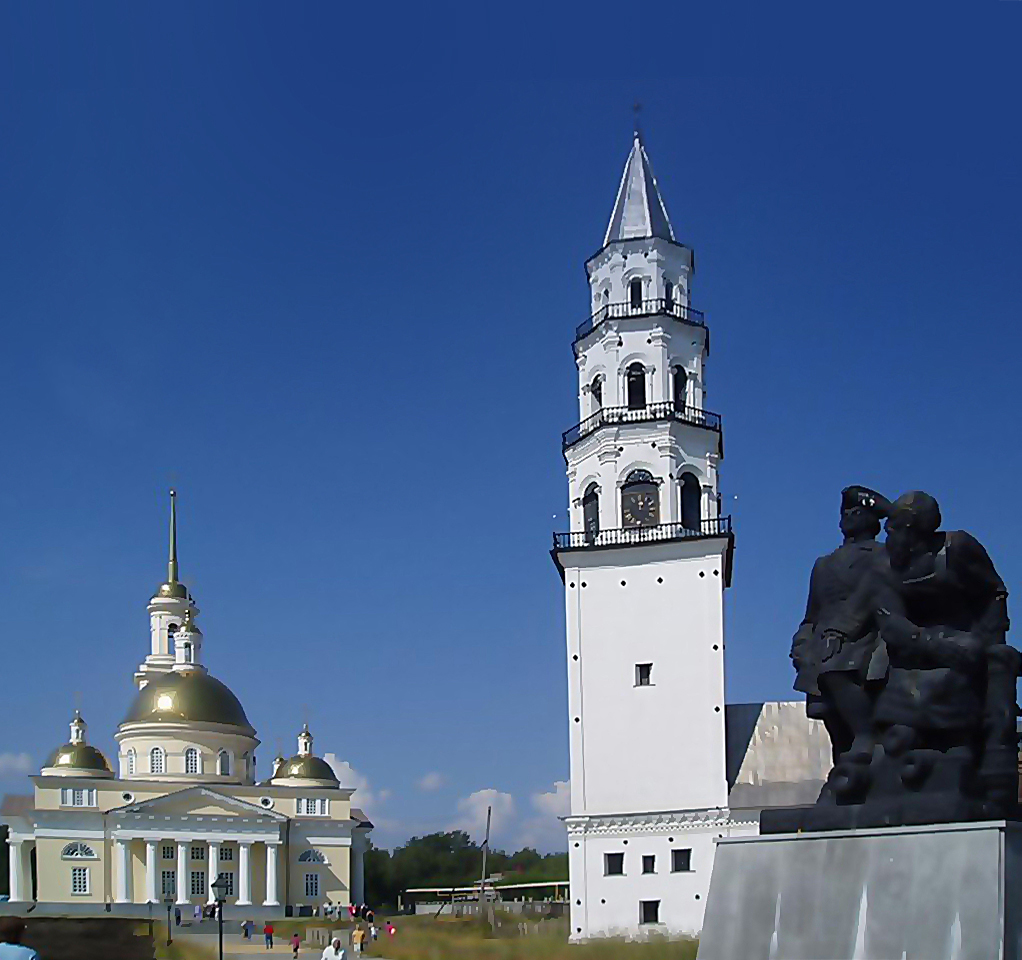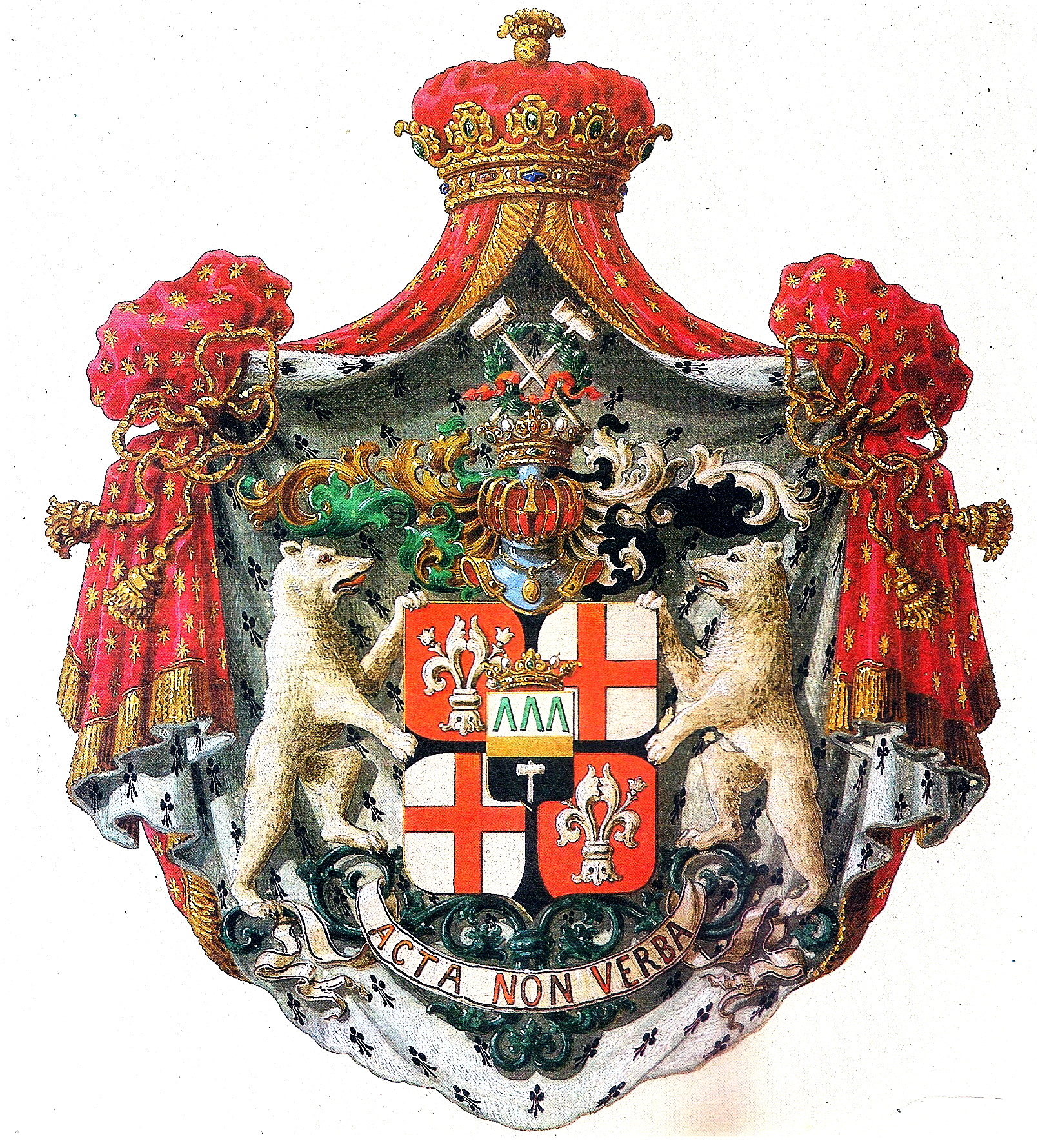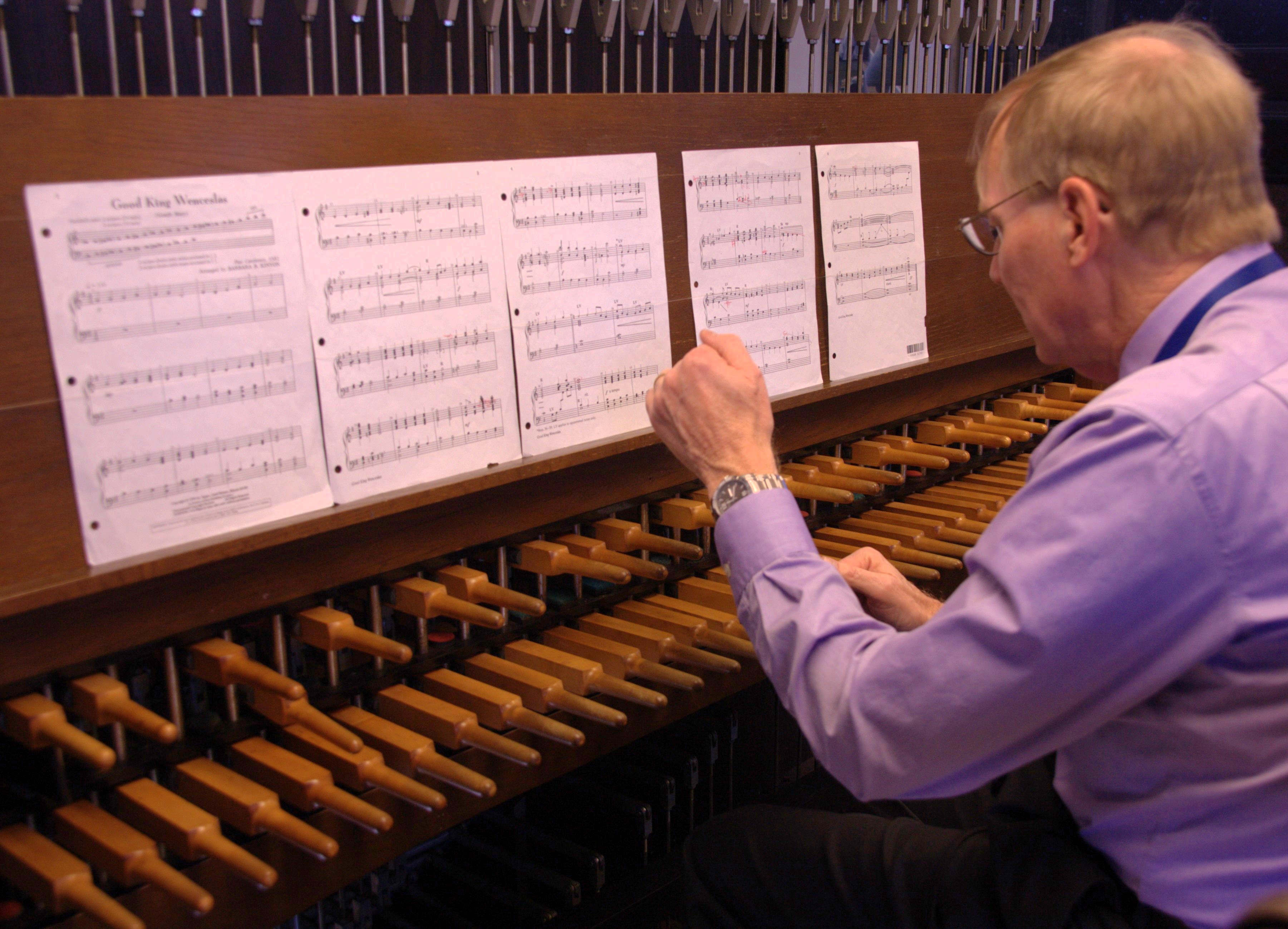|
Leaning Tower Of Nevyansk
The Leaning Tower of Nevyansk (russian: Невья́нская ба́шня) is a tower in the town of Nevyansk in Sverdlovsk Oblast, Russia, built in the 18th century. Its construction was funded by Peter the Great's associate Akinfiy Demidov, a famous Russian manufacturer and son of industrialist Nikita Demidov. The height of the tower is from the ground and the base is . The deviation of the top part of the tower from vertical is about 3 degrees. The exact date of construction is unknown, but Russian historians believe that it was built between 1721 and 1745. There is no information about the architect of this edifice. Technical parameters of the tower *The base is a square with sides of 9.5 metres. *Deviation of the tower from the vertical is about 1.85 metres. *Secular sediment is 0.9 millimetres per year. *The height is 57.5 metres. *The thickness of the walls is 2 metres at the base, 32 centimetres at the top level. *The weathercock weighs 25 kilograms and is ... [...More Info...] [...Related Items...] OR: [Wikipedia] [Google] [Baidu] |
Tower Nevyansk Overview
A tower is a tall structure, taller than it is wide, often by a significant factor. Towers are distinguished from masts by their lack of guy-wires and are therefore, along with tall buildings, self-supporting structures. Towers are specifically distinguished from buildings in that they are built not to be habitable but to serve other functions using the height of the tower. For example, the height of a clock tower improves the visibility of the clock, and the height of a tower in a fortified building such as a castle increases the visibility of the surroundings for defensive purposes. Towers may also be built for observation, leisure, or telecommunication purposes. A tower can stand alone or be supported by adjacent buildings, or it may be a feature on top of a larger structure or building. Etymology Old English ''torr'' is from Latin ''turris'' via Old French ''tor''. The Latin term together with Greek τύρσις was loaned from a pre-Indo-European Mediterranean lan ... [...More Info...] [...Related Items...] OR: [Wikipedia] [Google] [Baidu] |
Demidov Family
The House of Demidov (russian: Деми́довы) also Demidoff, was a prominent Russian noble family during the 18th and 19th centuries. Originating in the city of Tula in the 17th century, the Demidovs found success through metal products, and were entered into the European nobility by Peter the Great. Their descendants became among the most influential merchants and earliest industrialists in the Russian Empire, and at their peak were predicted to be the second-richest family in Russia, behind only the Russian Imperial Family. The Demidov family lost its fortune after the February Revolution of 1917, but continues to exist under the rendering Demidoff. History Their progenitor, Demid Antufiev, was a free blacksmith from Tula, where their family necropolis is preserved as a museum. His son Nikita Demidov (March 26, 1656November 17, 1725) made his fortune by his skill in the manufacture of weapons, and established an iron foundry for the government. Peter the Great, with who ... [...More Info...] [...Related Items...] OR: [Wikipedia] [Google] [Baidu] |
Demidov
The House of Demidov (russian: Деми́довы) also Demidoff, was a prominent Russian Empire, Russian noble family during the 18th and 19th centuries. Originating in the city of Tula, Russia, Tula in the 17th century, the Demidovs found success through metal products, and were entered into the European nobility by Peter the Great. Their descendants became among the most influential merchants and earliest industrialists in the Russian Empire, and at their peak were predicted to be the second-richest family in Russia, behind only the Russian Imperial Family. The Demidov family lost its fortune after the February Revolution, February Revolution of 1917, but continues to exist under the rendering Demidoff. History Their progenitor, Demid Antufiev, was a free blacksmith from Tula, Russia, Tula, where their family necropolis is preserved as a museum. His son Nikita Demidov (March 26, 1656November 17, 1725) made his fortune by his skill in the manufacture of weapons, and establis ... [...More Info...] [...Related Items...] OR: [Wikipedia] [Google] [Baidu] |
Richard Phelps (bell-founder)
Richard Phelps (c.1670–1738) was born in Avebury, Wiltshire, England. Phelps was a bellfounder, or a maker of bells, primarily for churches. He was master of the Whitechapel Bell Foundry in London from 1701 to 1738, and is best known for his large bell, Great Tom, in the steeple of St Paul's Cathedral in London, England. The foundry, in operation since at least 1570, was listed by the ''Guinness Book of Records'' as the oldest manufacturing company in Great Britain. Whitechapel foundry owner Little is known of Phelps before he became owner of Whitechapel. He took over the foundry on the death of the former foundry owner James Bartlett in January, 1701. Phelps remained as the head of the foundry for thirty-seven years, during which time the business grew to be the most successful in the kingdom. The bells that the foundry made were installed in many locations across England. Among his most well-known bells used to be hung in the steeples of St Michael-upon-Cornhill; St Magnus ... [...More Info...] [...Related Items...] OR: [Wikipedia] [Google] [Baidu] |
England
England is a country that is part of the United Kingdom. It shares land borders with Wales to its west and Scotland to its north. The Irish Sea lies northwest and the Celtic Sea to the southwest. It is separated from continental Europe by the North Sea to the east and the English Channel to the south. The country covers five-eighths of the island of Great Britain, which lies in the North Atlantic, and includes over 100 smaller islands, such as the Isles of Scilly and the Isle of Wight. The area now called England was first inhabited by modern humans during the Upper Paleolithic period, but takes its name from the Angles, a Germanic tribe deriving its name from the Anglia peninsula, who settled during the 5th and 6th centuries. England became a unified state in the 10th century and has had a significant cultural and legal impact on the wider world since the Age of Discovery, which began during the 15th century. The English language, the Anglican Church, and Engli ... [...More Info...] [...Related Items...] OR: [Wikipedia] [Google] [Baidu] |
Carillon
A carillon ( , ) is a pitched percussion instrument that is played with a keyboard and consists of at least 23 cast-bronze bells. The bells are hung in fixed suspension and tuned in chromatic order so that they can be sounded harmoniously together. They are struck with clappers connected to a keyboard of wooden batons played with the hands and pedals played with the feet. Often housed in bell towers, carillons are usually owned by churches, universities, or municipalities. They can include an automatic system through which the time is announced and simple tunes are played throughout the day. Carillons come in many designs, weights, sizes, and sounds. They are among the world's heaviest instruments, and the heaviest carillon weighs over . Most weigh between . To be considered a carillon, a minimum of 23 bells are needed; otherwise, it is called a chime. Standard-sized instruments have about 50, and the world's largest has 77 bells. The appearance of a carillon depends ... [...More Info...] [...Related Items...] OR: [Wikipedia] [Google] [Baidu] |
Clock
A clock or a timepiece is a device used to measure and indicate time. The clock is one of the oldest human inventions, meeting the need to measure intervals of time shorter than the natural units such as the day, the lunar month and the year. Devices operating on several physical processes have been used over the millennia. Some predecessors to the modern clock may be considered as "clocks" that are based on movement in nature: A sundial shows the time by displaying the position of a shadow on a flat surface. There is a range of duration timers, a well-known example being the hourglass. Water clocks, along with the sundials, are possibly the oldest time-measuring instruments. A major advance occurred with the invention of the verge escapement, which made possible the first mechanical clocks around 1300 in Europe, which kept time with oscillating timekeepers like balance wheels., pp. 103–104., p. 31. Traditionally, in horology, the term ''clock'' was used for a stri ... [...More Info...] [...Related Items...] OR: [Wikipedia] [Google] [Baidu] |
Gold
Gold is a chemical element with the symbol Au (from la, aurum) and atomic number 79. This makes it one of the higher atomic number elements that occur naturally. It is a bright, slightly orange-yellow, dense, soft, malleable, and ductile metal in a pure form. Chemically, gold is a transition metal and a group 11 element. It is one of the least reactive chemical elements and is solid under standard conditions. Gold often occurs in free elemental ( native state), as nuggets or grains, in rocks, veins, and alluvial deposits. It occurs in a solid solution series with the native element silver (as electrum), naturally alloyed with other metals like copper and palladium, and mineral inclusions such as within pyrite. Less commonly, it occurs in minerals as gold compounds, often with tellurium (gold tellurides). Gold is resistant to most acids, though it does dissolve in aqua regia (a mixture of nitric acid and hydrochloric acid), forming a soluble tetrachloroaurate anion. Gold is ... [...More Info...] [...Related Items...] OR: [Wikipedia] [Google] [Baidu] |
Silver
Silver is a chemical element with the Symbol (chemistry), symbol Ag (from the Latin ', derived from the Proto-Indo-European wikt:Reconstruction:Proto-Indo-European/h₂erǵ-, ''h₂erǵ'': "shiny" or "white") and atomic number 47. A soft, white, lustrous transition metal, it exhibits the highest electrical conductivity, thermal conductivity, and reflectivity of any metal. The metal is found in the Earth's crust in the pure, free elemental form ("native silver"), as an alloy with gold and other metals, and in minerals such as argentite and chlorargyrite. Most silver is produced as a byproduct of copper, gold, lead, and zinc Refining (metallurgy), refining. Silver has long been valued as a precious metal. Silver metal is used in many bullion coins, sometimes bimetallism, alongside gold: while it is more abundant than gold, it is much less abundant as a native metal. Its purity is typically measured on a per-mille basis; a 94%-pure alloy is described as "0.940 fine". As one of th ... [...More Info...] [...Related Items...] OR: [Wikipedia] [Google] [Baidu] |
Flue
A flue is a duct, pipe, or opening in a chimney for conveying exhaust gases from a fireplace, furnace, water heater, boiler, or generator to the outdoors. Historically the term flue meant the chimney itself. In the United States, they are also known as vents for boilers and as breeching for water heaters and modern furnaces. They usually operate by buoyancy, also known as the stack effect, or the combustion products may be 'induced' via a blower. As combustion products contain carbon monoxide and other dangerous compounds, proper 'draft', and admission of replacement air is imperative. Building codes, and other standards, regulate their materials, design, and installation. Heat retention Flues are adjustable and are designed to release noxious gases to the atmosphere. They often have the disadvantageous effect of releasing useful household heat to the atmosphere when not properly set—the very opposite of why the fire was lit in the first place. Fireplaces are one of the ... [...More Info...] [...Related Items...] OR: [Wikipedia] [Google] [Baidu] |
Soot
Soot ( ) is a mass of impure carbon particles resulting from the incomplete combustion of hydrocarbons. It is more properly restricted to the product of the gas-phase combustion process but is commonly extended to include the residual pyrolysed fuel particles such as coal, cenospheres, charred wood, and petroleum coke that may become airborne during pyrolysis and that are more properly identified as cokes or char. Soot causes various types of cancer and lung disease. Sources Soot as an airborne contaminant in the environment has many different sources, all of which are results of some form of pyrolysis. They include soot from coal burning, internal-combustion engines, power-plant boilers, hog-fuel boilers, ship boilers, central steam-heat boilers, waste incineration, local field burning, house fires, forest fires, fireplaces, and furnaces. These exterior sources also contribute to the indoor environment sources such as smoking of plant matter, cooking, oil lamps, candles, qu ... [...More Info...] [...Related Items...] OR: [Wikipedia] [Google] [Baidu] |
Metallurgical Furnace
A metallurgical furnace, more commonly referred to as a furnace, is a device used to heat and melt metal ore to remove gangue, primarily in Metal, iron and steel production. The heat energy to fuel a furnace may be supplied directly by fuel combustion, by electricity such as the electric arc furnace, or through induction heating in induction furnaces. There are several different types of furnaces used in metallurgy to work with specific metal and ores. Smelting furnaces Smelting furnaces are used in smelting to extract metal from ore. Smelting furnaces include: * The blast furnace, used to Redox, reduce iron ore to pig iron ** Cold blast ** Hot blast * Steelmaking furnaces, including: ** Puddling furnace ** Reverberatory furnace ** ** Open hearth furnace ** Basic oxygen furnace ** Electric arc furnace ** Electric induction furnace Other furnaces * Furnaces used to remelt metal in Foundry, foundries. * Furnaces used to reheat and Heat treatment, heat treat metal for use in: ... [...More Info...] [...Related Items...] OR: [Wikipedia] [Google] [Baidu] |









